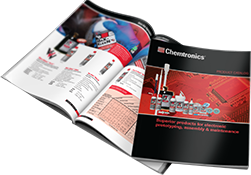
How do you repair a broken trace on a PCB?
A common method of repairing a broken trace is to solder on a jumper, which is basically a wire bypass around the broken trace. This can be time-consuming and visually unappealing. Chemtronics offers CircuitWorks® Conductive Pens, which contain...
Read This Post
How do I patch the conformal coating after a PCB repair?
Chemtronics offers CircuitWorks Overcoat Pens in a variety of colors to match the PCB resist. Overcoat pens are basically acrylic conformal coating in convenient packaging, and the clear version can be used to coat small areas. Simply press...
Read This Post
How do you remove conformal coating when repairing or reworking a PCB?
Chemtronics offers the CircuitWorks® Conformal Coating Remover Pen that allows you to remove a tight area of coating around a repair area without affecting the rest of the PCB. You first saturate the tip by tapping it lightly on a surface,...
Read This Post
How do you connect a temperature sensitive component without high temperature soldering?
2-part conductive epoxy is a great solution for making solderless electronic connections. This type of epoxy contains conductive material, so when cured, it forms a very strong and highly conductive bond, similar to a solder joint. Chemtronics...
Read This Post
Can I add my own flux to solder wick?
In a production or repair environment where the flux is specified and can’t be changed, or when an aqueous flux is needed, you can add your own flux to this type of braid. Unfluxed wick will not remove solder unless flux is added. Different...
Read This Post
Why is solder mask / resist / overcoat green?
Printed circuit boards (PCB) come in a variety of colors, including green, blue, red, brown, and even purple. The most common is green, but that can vary by application, industry, and the age of the PCB. Fashions change over time, and so do...
Read This Post
Are Tri-V cleaners good replacements for n-propyl bromide (nPB)?
Yes, Tri-V high performance solvent cleaners are nonflammable, powerful cleaners like nPB, safer than nPB, and are also economically priced.
Read This Post
How do you prevent the valve from clogging up when using aerosol conformal coating?
I suggest you get into the habit of clearing the valve after every use. You turn the can upside-down and spray until it only sprays propellant. If you don’t do that, you run the risk of dried coating building up in the valve or actuator...
Read This Post
What is desoldering wick made of?
Desoldering braid (wick) is made of fine strands of ultra-pure copper woven and coated with flux. Its geometrically precise weave design allows for maximum capillary action and solder capacity. Soder-wick optimizes heat transfer through the...
Read This Post
How do you use a desoldering wick?
1) Place the braid over unwanted solder, preferably on the greatest solder build up so that it maximizes the contact of the braid to the surface area of the solder. 2) Next, place your iron tip over the wick at 45 degrees and allow heat to transfer...
Read This Post


